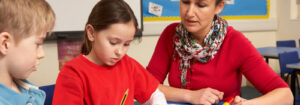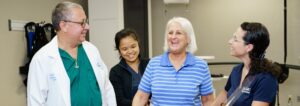Sensory Strategy Advice for Children with Autism

Back to physical health resource hub
April is National Autism Awareness Month. Statistics show as many as 90-95% of children with Autism and 16% of the general student population have difficulty with sensory processing and modulation. Sensory processing is how we receive and organize information from the environment and from our own bodies. All of our body’s senses are involved (auditory, visual, tactile, oral, proprioception, interoception and vestibular).
Sometimes our sensory preferences and sensory needs cause difficulty participating in our roles and routines. For a child, this may look like acting out, avoiding tasks, and having unwanted behaviors that limit the child’s ability to participate, play, learn and listen.
The purpose of this blog post is to share strategies to help you and your child have more success managing sensory-rich situations. Below are some practical strategies that you can try for any environment (birthday parties, doctor visits, grocery shopping, getting to school, etc.).
- Get enough rest
- Stick to a routine
- Prepare and explain changes in routine or upcoming events (social story, role-play, look at pictures of the location or activity, discuss the process)
- Pack calming items (stuffed animal, fidget toy, noise-canceling headphones or music, snack, weighted item
- Use a visual schedule or checklist for parts of the experience
- Take breaks and/or plan an “escape”
Below are some tips for common summertime scenarios that may present with sensory challenges:
| Theme parks |
|
| Eating out |
|
| Flying on a plane |
|
Your child’s preferences and sensory needs may change. Be patient and reflect on how previously strategies worked. If you are unable to navigate these challenges on your own, there are several resources online or you can talk to your child’s pediatrician about an occupational therapy referral to receive skilled guidance on an individualized sensory plan.
Resources:
- https://www.aota.org/-/media/corporate/files/aboutot/professionals/whatisot/cy/fact-sheets/factsheet_sensoryintegration.pdf
- https://www.growinghandsonkids.com/child-behavior-sensory-processing-resources
- Crasta E.C., Salzinger E., Lin M., Gavin W.J., Davies P.L. (2020). Sensory processing and attention profiles among children with sensory processing disorders and autism spectrum disorders. Front. Integr. Neuroscience. 15: 22. 10.3389/fnint.2020.00022
- Miller, Lucy Jane et al. “Identification of Sensory Processing and Integration Symptom Clusters: A Preliminary Study.” Occupational therapy international vol. 2017 2876080. 16 Nov. 2017, doi:10.1155/2017/2876080


